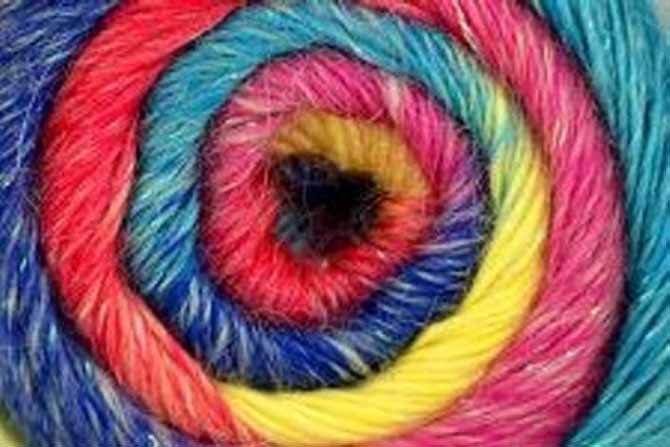All week, I’ve been working with and reviewing Alpaculence, a singles yarn in a light fingering weight, that has fiber content of 76% acrylic, 9% wool, 9% alpaca, and 6% glitter. It also has long spans of (usually 4) colors that repeat several times in every 100 gram ball.

The end of a skein of Alpaculence in the Rainbow Pyrite colorway. This one has five colors in every repeat!
There are pros and cons to working with both a singles yarn, and a yarn that has long color variegations. In today’s post, I’m going to lay some of these out for you.
Pros and cons of singles yarn
Pros
As the photo above shows, a singles yarn allows for excellent color saturation. When colored rovings are spun then plied, the color spans won’t often match up with one another, creating a “barber pole” effect. When different colors overlap, the saturation of the color could be compromised and the colors can look muddy from a distance.

This bulky yarn has 3 plies of different colors. When viewed from a distance, the yarn can look “muddy”
A singles yarn can have a smooth appearance. They’re often softly spun, and give the fabric a soft appearance.
Cons
As I discovered earlier in the week (and years ago) a singles yarn can bias, when knitted in stockinette stitch in flat or tubular shapes. It’s nothing that a little strategizing can’t fix, but it can limit pattern options.
The soft spin of a singles yarn can cause some yarns to drift apart when being knitted. Alpaculence held up fine, but I have worked with other soft-spun singles yarn in a bulky weight that has “melted” in my hands.
Pros and cons of variegated yarns
Pros
The numerous yarns available today with long spans of variegated colors have been a boon to designers. Suddenly entrelac could be made to look as if it was made with many colors when in reality it’s only one ball. Modular knits, mitered squares and “10 stitch” designs have all benefited from yarns with long variegations. We must remember, too, that this all started with socks!
Long spans of color also make it more practical to do projects that have long rows, such as shawls or blankets.

The gorgeous Lace Edge Garter Stitch Shawl shows how the stripes are wide near the neck, where the knitting starts, then narrow down toward the edging. The edging, worked sideways, has wider stripes again.
Cons
Self-striping yarns are great for projects that have little shaping, but when the row count changes often, the depth of the stripes will vary. Sleeves, for example usually have fewer stitches than the front or back of a sweater, so the stripes on the sleeves will be wider than the stripes on the body pieces.
Our beautiful Lace Edge Garter Stitch (photo above) gives us an excellent example of how stitch counts affect the striping with yarn that has long stretches of color.
When stitch counts change, it sometimes causes “color pooling”, unattractive blotches of colors in sometimes undesirable places. (I once had a variegated sweater drop a blob of two different colors right over the chest of a sweater for myself – yup, one on each side. It happened when the stitch count changed at the armholes. The fact that a similar thing happened on the back of the sweater was little consolation!)
In the case of the toque in the photo below, the change in stitch count caused the colors to appear to spiral in different directions.

This acrylic toque has a wedge of hot pink where the decreases begin, and the colors start to spiral in the opposite direction to the rest of the hat.
Knots in a ball of yarn can cause sudden “jolts” of color, and it’s sometimes necessary to reel off a length of yarn until you can approximate the same point in the color repeat. Sometimes this piece of yarn can be used elsewhere in the project, but sometimes, it becomes part of the leftovers.
This concludes my week of Alpaculence. Remember to send us pictures of your Alpaculence projects, and, if you have any other pros or cons about working with singles or variegated yarns, write and share them with us!
This is part 5 of 5 in this series.
Go back to part 4: The pattern hunt for Alpaculence yarn
